Can a skyscraper blown away?
On Monday, a snow storm and a hurricane wind hit Petersburg — up to 23 m / s along the coast and slightly lower in other areas.

A couple of days ago on the streets of the city ... (Photo from here )
Can a skyscraper be blown off with such a wind? And how can? Let's understand - of course, on the example of the “Lakhta Center” being built in the northern capital.
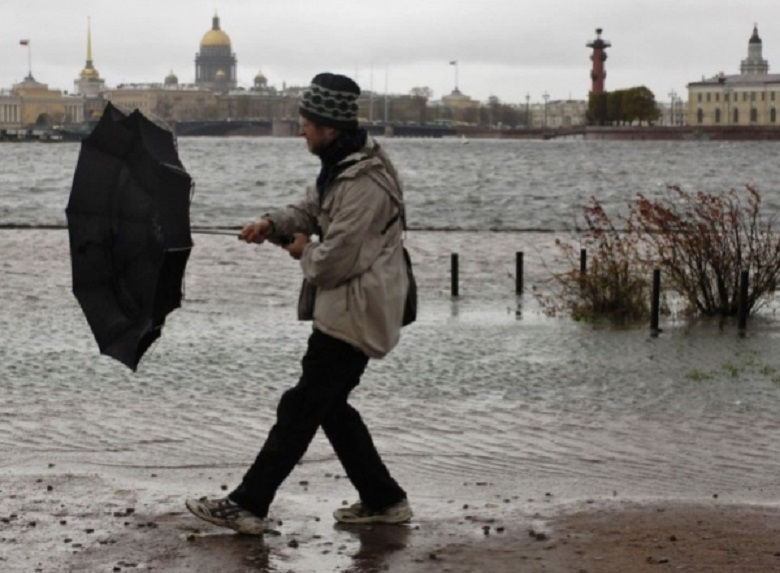
(Photo - from here ).
')
Wind is one of the important components of the bad reputation of the St. Petersburg climate. It is believed that in the city on the Neva is always "cold and blowing." But let's be frank - if you take the wind separately, without a friendly company in the form of humidity, cold and variability of the weather, then in itself it does not stand out beyond the limits of rather average national values. Even so: in Russia there are many places where the blows are much stronger.

Map of wind pressure values for different regions of Russia ( source )
Of course, in the case of St. Petersburg there is a difference in which area of the city the building is located. The windiest areas are adjacent to the Gulf of Finland. The difference in wind speed can be 3-4 m / s or more, of course, in favor of the coast.

A prototype of folklore on the theme of V.O. - Wyoming state windsock , which, however, does not make a local remake of a joke less popular among those who know firsthand about island life.
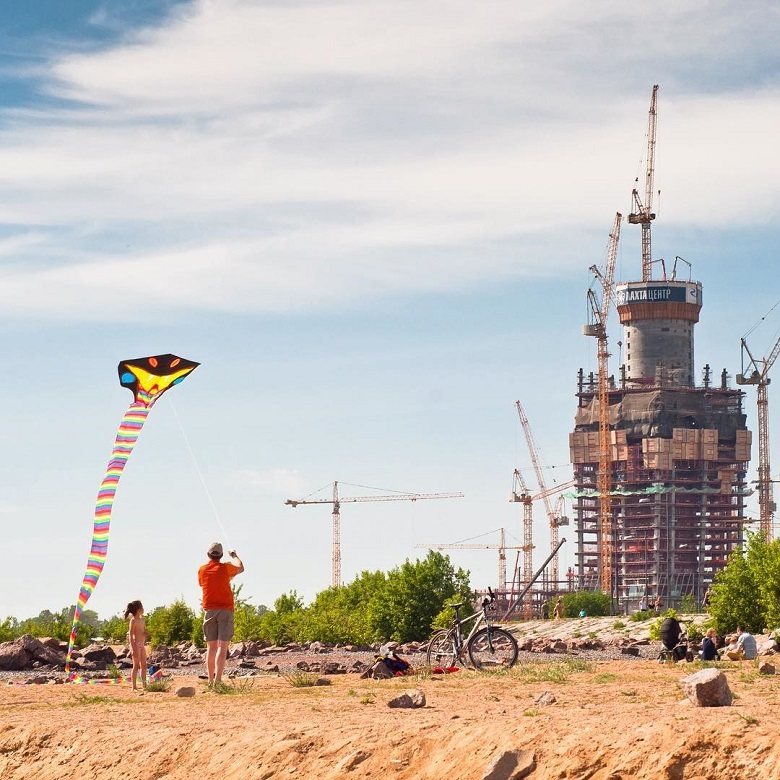
“Lakhta Center” will be located just in such a “windy” Primorsky district - on the harbor, in a favorite place of kiters and sympathizers, who, as you know, the stronger they blow, the better they fly.
But even such a “strengthened” wind is unable to harm the tower. But he can cause inconvenience to those on its upper floors, causing quite noticeable fluctuations.
The response of the Lakhta Center designers to this climate challenge is the modern construction of the sustainability of a skyscraper: outriggers + core + external columns. She will also save the tower from more extreme cases of “horizontal” impact.
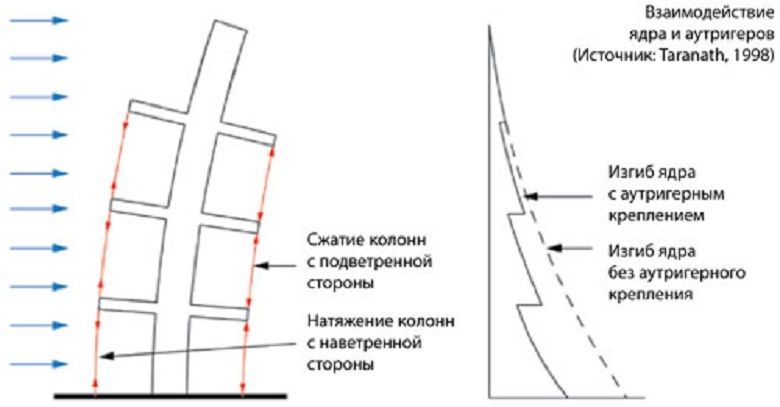
The response of the system of stability of skyscrapers to the contact horizontal load (wind, impact)
Outrigger floor - powerful horizontal metal structures - an integral part of the Supertoll stability system. Such elements are for the skyscraper peculiar stiffening rings that “hold the shape” of the building in the horizontal plane.
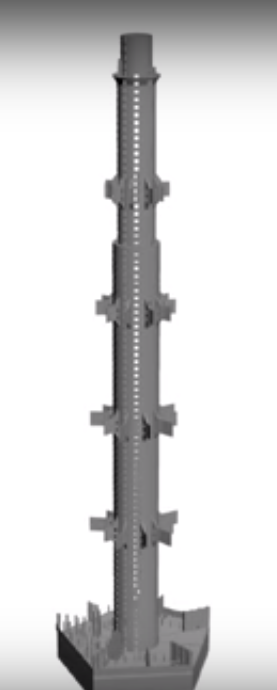
The vertical structure is the core of the tower, and the horizontal elements are the outriggers.
This scheme was first tested in Asia - a region of skyscrapers and increased seismic activity.
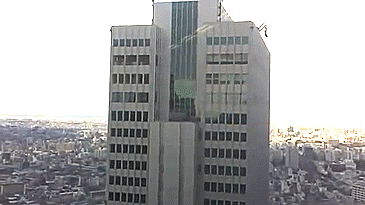
Swinging skyscrapers in Tokyo are not uncommon.
Today, outrigger technology allows architects to design sustainable skyscrapers of various shapes.
Outrigger floors help distribute the load between the core and the columns. Even if the tower will be exposed to a single-stage destructive impact (aircraft strike) - the consequences should be minimized. In practice, this means that even if part of the perimeter columns is destroyed in the Lakhta Center, outriggers will distribute the load on the remaining elements of stability.
A similar scheme of work outriggers - with less extreme and just "living conditions" - with a hurricane or standard wind: distribute the load and then quench it.
Outrigger systems can be horizontal, diagonal, double-decker or without girdling trusses or vertical connections. The design for each high-rise building is unique, and depending on its height, it can be different within the same object.
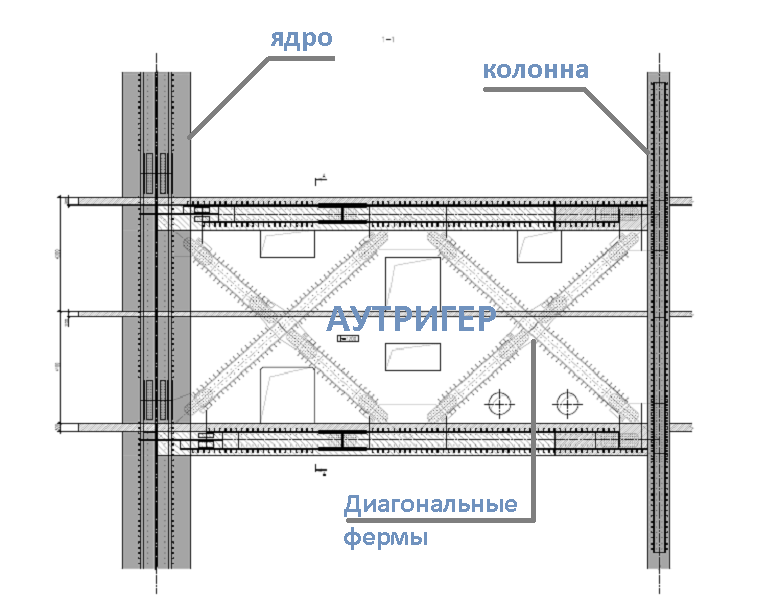
The internal structure of the horizontal composite outrigger Lakhta Center. The height of the farm two floors of the building - 8.4 meters
Structurally, the outriggers perform several functions at once: an increase in the flexural rigidity of the building, resistance to wind loads, and resistance to progressive collapse.
What is progressive collapse?
The mechanism demonstrates pulling the card out of the house of cards: one structure that is responsible for stability collapsed - all the rest fell down. Collapse is growing exponentially.

Constructions that prevent progressive collapse are one of the mandatory requirements after the events of 9/11 ( imgur.com )
The central core can provide sufficient resistance to the overturning moment and prevent the building from “drifting”. The question of introducing outriggers into the carrier structure is considered if the building has more than 40 floors.
So, the wind will cause acceleration at the very top of the building. In order for these accelerations to make people feel comfortable, being in a tower, the oscillations-frequencies must be controlled.
Based on aerodynamic testing data, a decision was made on the outrigger elements of the tower stability system. In the Lakhta Center skyscraper there will be four outrigger floors and a fifth, atypical outrigger constructed in the form of a 1.5-meter concrete slab on the 82nd floor.
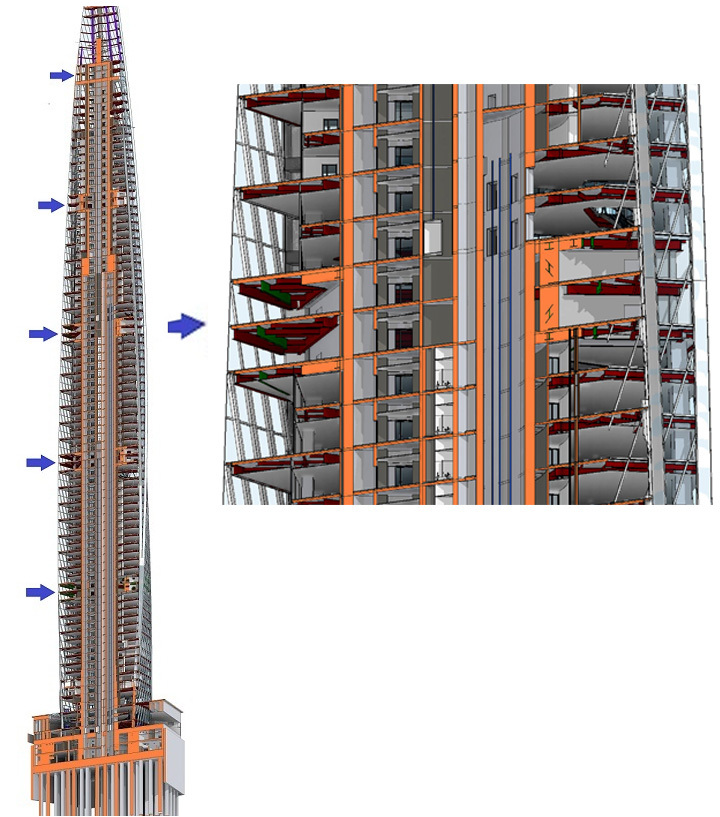
Layout of outrigger levels in “Lakhta Center”
Taking into account the torsion of the Lakhta Center form and turning the building by 89 degrees, the construction of outrigger floors is a crucial stage and hard work, comparable to the manufacture of the foundation. During the subsequent operation of the building, the outrigger floors will become technical. They will house equipment and communications nodes.
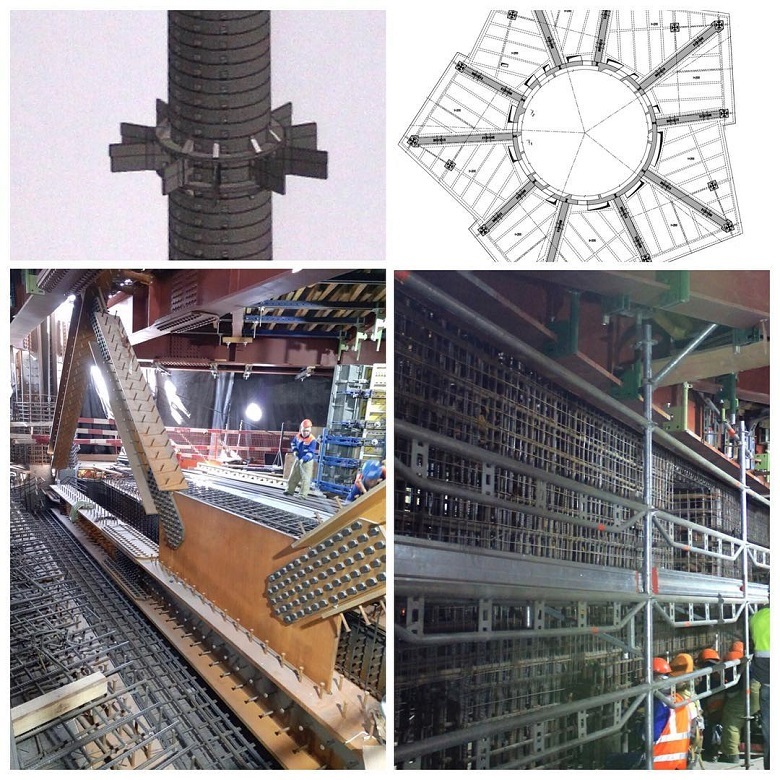
Outrigger floors of Lakhta Center
Thanks to the described design features, the tower will have a minimal, compared to many other skyscrapers, amplitude of horizontal vibrations. The maximum deviation under the influence of the "average" St. Petersburg wind at the level of the observation platform will be 27 cm. This value is almost not noticeable. For example, the inhabitants of the Federation Tower do not notice deviations, the size of which is up to 46 cm along the top.
As for more extreme cases, then, according to research, peak wind loads on a skyscraper will be about 500 Pascals. Wind in Lakhta is waiting for such a force once every 5 years. This corresponds to a wind speed of about 30 m / s. For comparison, approximately in this pace hurricane “Saint Jude” passed through the city in 2013.
And one more important indicator. Due to the introduction of outrigger belts into the stability system of the tower, the skyscraper will be able to withstand earthquakes of up to 6 points. This is quite enough: for Petersburg, manifestations of seismic activity are rare - in the entire history of the city there were less than 10 of them, the strength of the shocks did not exceed 2-3 Richter points.
One of the parameters of aerodynamic testing - pedestrian comfort. Skyscrapers have such a feature: when a high-rise building stands next to others, then a concentration of wind flows occurs. Down wind speed increases. This is what we often call the "pipe".
A classic example of a "pipe" is a doorway, or a narrow passage between houses. Sometimes "analog" may be formed due to the unsuccessful relative position of high-rise buildings.
To avoid discomfort for pedestrians, wind analysis is done at the very beginning of construction.
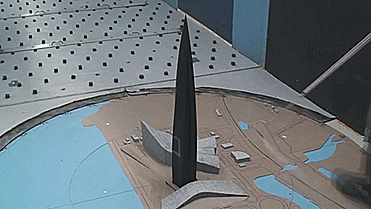
Fragment of aerodynamic tests of the Lakhta Center layout in Novosibirsk (video is accelerated).
The layout is equipped with sensors. The platform with the model of the tower rotates, while the "wind" blows from one side. The specialist blows the "tower", revealing the worst position of the layout relative to the "wind". Another tower purge took place in Canada.
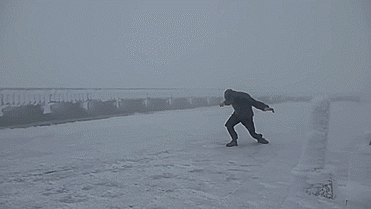
Frozen and blown away. In the "Lakhta Center" such an attraction is not planned.
-
Video on the topic. Damper - an alternative to outriggers

A couple of days ago on the streets of the city ... (Photo from here )
Can a skyscraper be blown off with such a wind? And how can? Let's understand - of course, on the example of the “Lakhta Center” being built in the northern capital.
Construction climatology. Task about the wind

(Photo - from here ).
')
Wind is one of the important components of the bad reputation of the St. Petersburg climate. It is believed that in the city on the Neva is always "cold and blowing." But let's be frank - if you take the wind separately, without a friendly company in the form of humidity, cold and variability of the weather, then in itself it does not stand out beyond the limits of rather average national values. Even so: in Russia there are many places where the blows are much stronger.

Map of wind pressure values for different regions of Russia ( source )
Of course, in the case of St. Petersburg there is a difference in which area of the city the building is located. The windiest areas are adjacent to the Gulf of Finland. The difference in wind speed can be 3-4 m / s or more, of course, in favor of the coast.

A prototype of folklore on the theme of V.O. - Wyoming state windsock , which, however, does not make a local remake of a joke less popular among those who know firsthand about island life.

“Lakhta Center” will be located just in such a “windy” Primorsky district - on the harbor, in a favorite place of kiters and sympathizers, who, as you know, the stronger they blow, the better they fly.
But even such a “strengthened” wind is unable to harm the tower. But he can cause inconvenience to those on its upper floors, causing quite noticeable fluctuations.
The response of the Lakhta Center designers to this climate challenge is the modern construction of the sustainability of a skyscraper: outriggers + core + external columns. She will also save the tower from more extreme cases of “horizontal” impact.

The response of the system of stability of skyscrapers to the contact horizontal load (wind, impact)
What are outriggers in a skyscraper?
Outrigger floor - powerful horizontal metal structures - an integral part of the Supertoll stability system. Such elements are for the skyscraper peculiar stiffening rings that “hold the shape” of the building in the horizontal plane.

The vertical structure is the core of the tower, and the horizontal elements are the outriggers.
This scheme was first tested in Asia - a region of skyscrapers and increased seismic activity.

Swinging skyscrapers in Tokyo are not uncommon.
Today, outrigger technology allows architects to design sustainable skyscrapers of various shapes.
What is the point?
Outrigger floors help distribute the load between the core and the columns. Even if the tower will be exposed to a single-stage destructive impact (aircraft strike) - the consequences should be minimized. In practice, this means that even if part of the perimeter columns is destroyed in the Lakhta Center, outriggers will distribute the load on the remaining elements of stability.
The assumption “if an airplane flies into the tower” after the 9/11 tragedy became mandatory in the design of all skyscrapers and was reflected in changes in technical regulations for the design and construction of superhigh-heights.
A similar scheme of work outriggers - with less extreme and just "living conditions" - with a hurricane or standard wind: distribute the load and then quench it.
Outrigger systems can be horizontal, diagonal, double-decker or without girdling trusses or vertical connections. The design for each high-rise building is unique, and depending on its height, it can be different within the same object.

The internal structure of the horizontal composite outrigger Lakhta Center. The height of the farm two floors of the building - 8.4 meters
Why is this necessary?
Structurally, the outriggers perform several functions at once: an increase in the flexural rigidity of the building, resistance to wind loads, and resistance to progressive collapse.
What is progressive collapse?
The mechanism demonstrates pulling the card out of the house of cards: one structure that is responsible for stability collapsed - all the rest fell down. Collapse is growing exponentially.

Constructions that prevent progressive collapse are one of the mandatory requirements after the events of 9/11 ( imgur.com )
The central core can provide sufficient resistance to the overturning moment and prevent the building from “drifting”. The question of introducing outriggers into the carrier structure is considered if the building has more than 40 floors.
Outriger levels of Lakhta Center
So, the wind will cause acceleration at the very top of the building. In order for these accelerations to make people feel comfortable, being in a tower, the oscillations-frequencies must be controlled.
“How to do it in the best way is determined after blowing the entire building in a wind tunnel,” says Sergey Nikiforov, chief engineer of Lakhta Center. - When such a test occurs, the most reliable data on the wind pressure on the facade appear, and from this it is determined what oscillations and frequencies arise, how to calculate the stability of the building, how to fix the facade. By bringing all these unknowns together, and the wind is a function of all these unknowns, we came to the decision how to make the best designs. The highlight of the whole process is exactly how to do everything rationally and optimally, without excessively increasing and thickening the structures, so that the engineering equipment and people have enough space.
Based on aerodynamic testing data, a decision was made on the outrigger elements of the tower stability system. In the Lakhta Center skyscraper there will be four outrigger floors and a fifth, atypical outrigger constructed in the form of a 1.5-meter concrete slab on the 82nd floor.

Layout of outrigger levels in “Lakhta Center”
Taking into account the torsion of the Lakhta Center form and turning the building by 89 degrees, the construction of outrigger floors is a crucial stage and hard work, comparable to the manufacture of the foundation. During the subsequent operation of the building, the outrigger floors will become technical. They will house equipment and communications nodes.

Outrigger floors of Lakhta Center
Thanks to the described design features, the tower will have a minimal, compared to many other skyscrapers, amplitude of horizontal vibrations. The maximum deviation under the influence of the "average" St. Petersburg wind at the level of the observation platform will be 27 cm. This value is almost not noticeable. For example, the inhabitants of the Federation Tower do not notice deviations, the size of which is up to 46 cm along the top.
As for more extreme cases, then, according to research, peak wind loads on a skyscraper will be about 500 Pascals. Wind in Lakhta is waiting for such a force once every 5 years. This corresponds to a wind speed of about 30 m / s. For comparison, approximately in this pace hurricane “Saint Jude” passed through the city in 2013.
And one more important indicator. Due to the introduction of outrigger belts into the stability system of the tower, the skyscraper will be able to withstand earthquakes of up to 6 points. This is quite enough: for Petersburg, manifestations of seismic activity are rare - in the entire history of the city there were less than 10 of them, the strength of the shocks did not exceed 2-3 Richter points.
To pedestrians are not blown away
One of the parameters of aerodynamic testing - pedestrian comfort. Skyscrapers have such a feature: when a high-rise building stands next to others, then a concentration of wind flows occurs. Down wind speed increases. This is what we often call the "pipe".
A classic example of a "pipe" is a doorway, or a narrow passage between houses. Sometimes "analog" may be formed due to the unsuccessful relative position of high-rise buildings.
To avoid discomfort for pedestrians, wind analysis is done at the very beginning of construction.

Fragment of aerodynamic tests of the Lakhta Center layout in Novosibirsk (video is accelerated).
The layout is equipped with sensors. The platform with the model of the tower rotates, while the "wind" blows from one side. The specialist blows the "tower", revealing the worst position of the layout relative to the "wind". Another tower purge took place in Canada.
“When the rate of blowing is known, it is already decided to move buildings away from each other or to change the shape-profile of buildings,” explains Sergey Nikiforov. - A similar exercise was done here, at the very beginning. As a result, one building was slightly moved away from another in order to create a comfort zone in case of whirlwind gusts of wind.

Frozen and blown away. In the "Lakhta Center" such an attraction is not planned.
-
Video on the topic. Damper - an alternative to outriggers
Source: https://habr.com/ru/post/399809/
All Articles